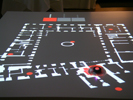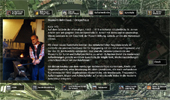| |
| | |
|
|
Museum Technology
How to provide ubiquitous infosystems?
|
| | |
 Ubiquitous Computing Ubiquitous Computing
 Ubiquitous Media Ubiquitous Media
 Hybrary - Hybrid Library Hybrary - Hybrid Library
Museum Technology
 Pervasive Gaming Pervasive Gaming
 Color Quantization Color Quantization
 Image Compression Image Compression
 Quality of Service Quality of Service
 Intelligent Internet Services Intelligent Internet Services
 Seamless Media Adaptation Seamless Media Adaptation
 Supervised Theses Supervised Theses

|
Museums have been always at the forefront of technology usage to present exhibitions in the best way to encourage
exploration of knowledge and to optimize the pleasure of the visit. Multimedia Technology offers new possibilities
for enhancing the possibilities of conventional museums and virtual museums in the cyberspace.
At the ISNM we developed projects for bridging the gap between the real and virtual spaces by using advanced technologies.
The main interest areas are methods and mechanisms for improving the museum infrastructure for both the visitor and the curator.
This includes preparation of exhibitions and visits, on-tour guidance with virtual agents and kiosk systems as well as an
after-processing of the visit by automatic documentation generation, etc.
|
| | |






|
 Eutin MagicTable Eutin MagicTable
How to design invisible interfaces?
The Magic Table is an interactive information system developed for the Castle Museum of Eutin.
The medieval castle of the bishops of Lübeck was residence of the dukes of Oldenburg. After twenty years
of renovation it is now a public museum. The baroque castle church with the precious organ of Arp Schnittger
is a highlight of north german architecture.
The artistic concept of the system presentation supports the visitor with unusual perspectives on architectures,
history and inhabitants of the castle. The system architecture was developed by a student team of the ISNM
in summer 2005 and installed in the museum in 2006. By using RFID reader below the table, a tangible interface
is realized without the need for mouse and keyboard. Two projectors are used to beam the interactive surface
onto the table and the information surface to the wall. A transparent puck containing an RFID label is used
for selecting certain aspects of the information by moving on the table surface.
The presentation and interaction surface is based on Flash and supports any type of media. Professional
soundtrack has been composed and videos of aspects of the museum exhibitions have been provided by the
cooperation partner.
An XML-based content management system allows for updating the system with new content.
This project was sponsored by the
 Eutin Castle Foundation
and produced in cooperation with Art.Too in Malente, Germany.
Eutin Castle Foundation
and produced in cooperation with Art.Too in Malente, Germany.
|
| | |


|
Details about the Eutin Magic table can be found in:
Andreas Schrader, Abdul Ahad, Darren Carlson, Brian Egan, Jörg Kaminski and Juliane Moser
Das begreifbare Museum - Ein interaktives Informationssystem
Demonstration at the
 Mensch & Computer 2005 Conference of the GI and the German Chapter of the ACM
Linz, Austria, September 4-7, 2005.
In: C. Stary (Ed.): Mensch & Computer 2005: Kunst und Wissenschaft – Grenzüberschreitungen
der interaktiven ART. Oldenbourg Verlag, Munich, Germany, 2005, pp. 261-265.
Mensch & Computer 2005 Conference of the GI and the German Chapter of the ACM
Linz, Austria, September 4-7, 2005.
In: C. Stary (Ed.): Mensch & Computer 2005: Kunst und Wissenschaft – Grenzüberschreitungen
der interaktiven ART. Oldenbourg Verlag, Munich, Germany, 2005, pp. 261-265.
Download  paper.
paper.
See also several newspaper articles at  media coverage section.
media coverage section.
|
| | |



|
 Luebeck Museum Luebeck Museum
How to visit all museums of Luebeck in 5 minutes?
A smaller version of this Eutin Magic Table has been created for the
 Cultural Foundation of Lübeck
as a showcase for the Luebeck museums in an exhibition during the event "Uni im Dialog" (University
in Dialog) in the
Cultural Foundation of Lübeck
as a showcase for the Luebeck museums in an exhibition during the event "Uni im Dialog" (University
in Dialog) in the
 St. Petri Church
of Luebeck, on June 1st, 2006.
St. Petri Church
of Luebeck, on June 1st, 2006.
The flash based demo starts with a flight from outer space to the Luebeck old town using
Google Earth(R) and provides visitors with short information about an institution
when the RFID puck is moved over the respective icon.
|
| | |

|
Thanks to Luis Bustamante and Michal Janiszewski, who quickly found out, that table-top beaming
is a nice idea, as long as you don't have to hang the beamer on a church ceiling of 25m height.
But thanks to the curator, climbing the ceiling, we finally managed.
For a short impression of the demo start this
 Flash Animation. Flash Animation.
(Please note that the demo will only show parts without the RFID interface).
|
| | |






|
 Holstentour Holstentour
How to use your mobile phone in the museum?
Museums and exhibitions, which form an integral part of the cultural heart of society,
are seeing increasing demands for contextualised exhibition services at every stage of the museum experience i.e. before,
during and after a museum visit. Contextualisation aims to elicit a more engaging experience in order to enrich visitors’
learning and enjoyment. Moreover, services, such as exploring, remembering, explaining, communicating, are needed to support
museums’ essential functions, particularly, interpretation and exhibition.
In this research, performed as a Master Thesis at the ISNM (Bashar Al Takrouri), a novel infrastructure, called Medient
Infrastructure is based on Web Services, Service Oriented Architecture and an Event-driven approach.
As a prototype, the "Holstentour" project was realized as a class project of "Ubiquitous Computing" in 2007.
No special installation is required, hence, visitors can use their personal mobile devices easily and effectively.
Furthermore, museums are free to design their own mobile and stationary context-aware applications.
Basic, advanced and environmental context information is gathered to support a ubiquitous museum information environment
to support multimedia content delivery on Bluetooth-enabled and AJAX supported mobile devices.
The system can also be used in other environments, e.g. university campus, hospitals, etc.
This project was sponsored by the ULR - Unabhängige Landesanstalt für Rundfunk und Neue Medien
(now  www.ma-sh.de),
the regional office for radio broadcasting and new media of Schleswig-Holstein, Germany.
and produced in cooperation with the www.ma-sh.de),
the regional office for radio broadcasting and new media of Schleswig-Holstein, Germany.
and produced in cooperation with the
 Cultural Foundation of Lübeck, Germany.
Cultural Foundation of Lübeck, Germany.
More information about Medient and the HolstenTour project can be found in:
|
| | |

|
Bashar Al Takrouri, Andreas Schrader
Ambient Media Services in Intelligent Environments
5th International Conference on Intelligent Environments (IE09)
July 20-21, 2009, Barcelona, Spain.
|
| | |

|
The Holstentour project and the Medient infrastructure was presented at the Learntec Conference 2008 in Karlsruhe
 Learntec 2008, January 30th, 2008.
Learntec 2008, January 30th, 2008.
|
| | |

|
See also  press report
in
press report
in  Luebecker Nachrichten
from March, 5th, 2008.
Luebecker Nachrichten
from March, 5th, 2008.
|
|
|
|